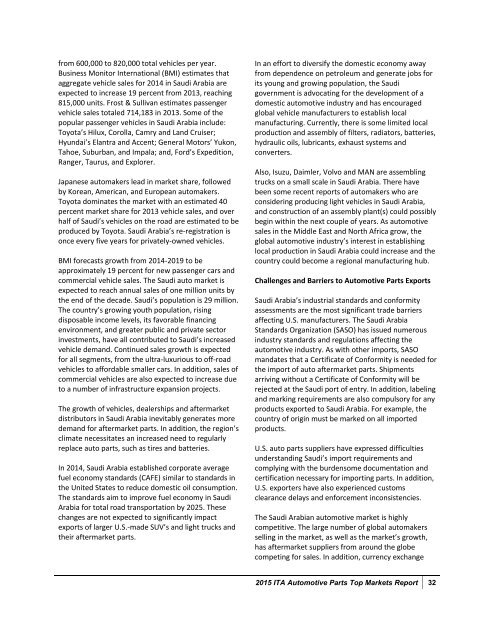Automotive Parts
Autoparts_Top_Markets_Report
Autoparts_Top_Markets_Report
You also want an ePaper? Increase the reach of your titles
YUMPU automatically turns print PDFs into web optimized ePapers that Google loves.
from 600,000 to 820,000 total vehicles per year.Business Monitor International (BMI) estimates thataggregate vehicle sales for 2014 in Saudi Arabia areexpected to increase 19 percent from 2013, reaching815,000 units. Frost & Sullivan estimates passengervehicle sales totaled 714,183 in 2013. Some of thepopular passenger vehicles in Saudi Arabia include:Toyota’s Hilux, Corolla, Camry and Land Cruiser;Hyundai’s Elantra and Accent; General Motors’ Yukon,Tahoe, Suburban, and Impala; and, Ford’s Expedition,Ranger, Taurus, and Explorer.Japanese automakers lead in market share, followedby Korean, American, and European automakers.Toyota dominates the market with an estimated 40percent market share for 2013 vehicle sales, and overhalf of Saudi’s vehicles on the road are estimated to beproduced by Toyota. Saudi Arabia’s re-registration isonce every five years for privately-owned vehicles.BMI forecasts growth from 2014-2019 to beapproximately 19 percent for new passenger cars andcommercial vehicle sales. The Saudi auto market isexpected to reach annual sales of one million units bythe end of the decade. Saudi’s population is 29 million.The country’s growing youth population, risingdisposable income levels, its favorable financingenvironment, and greater public and private sectorinvestments, have all contributed to Saudi’s increasedvehicle demand. Continued sales growth is expectedfor all segments, from the ultra-luxurious to off-roadvehicles to affordable smaller cars. In addition, sales ofcommercial vehicles are also expected to increase dueto a number of infrastructure expansion projects.The growth of vehicles, dealerships and aftermarketdistributors in Saudi Arabia inevitably generates moredemand for aftermarket parts. In addition, the region’sclimate necessitates an increased need to regularlyreplace auto parts, such as tires and batteries.In 2014, Saudi Arabia established corporate averagefuel economy standards (CAFE) similar to standards inthe United States to reduce domestic oil consumption.The standards aim to improve fuel economy in SaudiArabia for total road transportation by 2025. Thesechanges are not expected to significantly impactexports of larger U.S.-made SUV’s and light trucks andtheir aftermarket parts.In an effort to diversify the domestic economy awayfrom dependence on petroleum and generate jobs forits young and growing population, the Saudigovernment is advocating for the development of adomestic automotive industry and has encouragedglobal vehicle manufacturers to establish localmanufacturing. Currently, there is some limited localproduction and assembly of filters, radiators, batteries,hydraulic oils, lubricants, exhaust systems andconverters.Also, Isuzu, Daimler, Volvo and MAN are assemblingtrucks on a small scale in Saudi Arabia. There havebeen some recent reports of automakers who areconsidering producing light vehicles in Saudi Arabia,and construction of an assembly plant(s) could possiblybegin within the next couple of years. As automotivesales in the Middle East and North Africa grow, theglobal automotive industry’s interest in establishinglocal production in Saudi Arabia could increase and thecountry could become a regional manufacturing hub.Challenges and Barriers to <strong>Automotive</strong> <strong>Parts</strong> ExportsSaudi Arabia’s industrial standards and conformityassessments are the most significant trade barriersaffecting U.S. manufacturers. The Saudi ArabiaStandards Organization (SASO) has issued numerousindustry standards and regulations affecting theautomotive industry. As with other imports, SASOmandates that a Certificate of Conformity is needed forthe import of auto aftermarket parts. Shipmentsarriving without a Certificate of Conformity will berejected at the Saudi port of entry. In addition, labelingand marking requirements are also compulsory for anyproducts exported to Saudi Arabia. For example, thecountry of origin must be marked on all importedproducts.U.S. auto parts suppliers have expressed difficultiesunderstanding Saudi’s import requirements andcomplying with the burdensome documentation andcertification necessary for importing parts. In addition,U.S. exporters have also experienced customsclearance delays and enforcement inconsistencies.The Saudi Arabian automotive market is highlycompetitive. The large number of global automakersselling in the market, as well as the market’s growth,has aftermarket suppliers from around the globecompeting for sales. In addition, currency exchange2015 ITA <strong>Automotive</strong> <strong>Parts</strong> Top Markets Report 32


